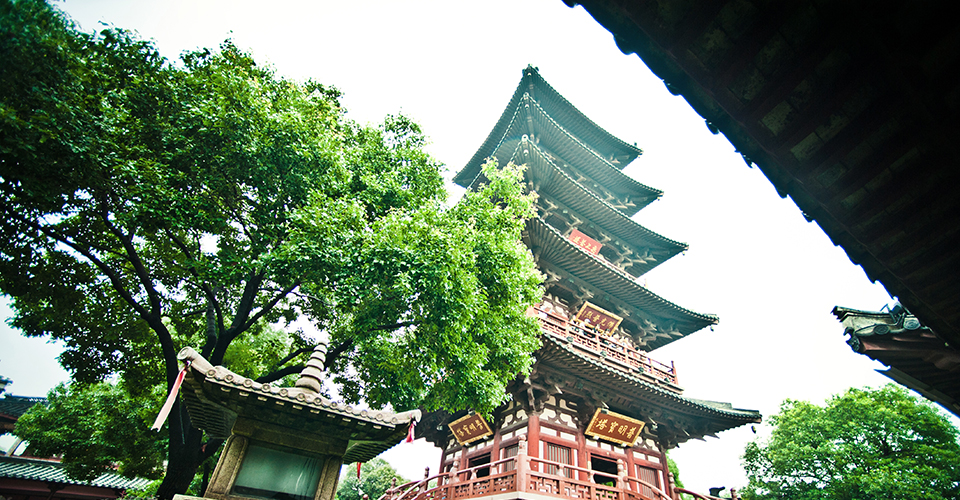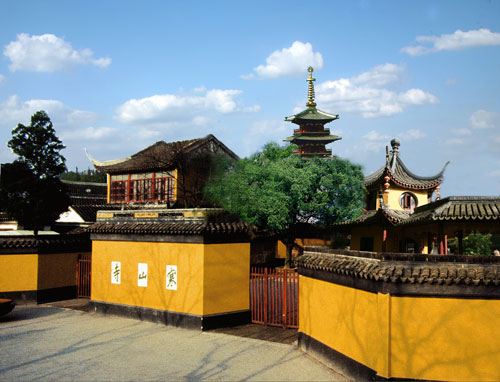It's also known as "Cold Mountain Temple", a name conjuring up images of a snowy alpine monastery, but Hanshan Temple isn't named for its setting. It honors one of its former abbots, the legendary monk and poet Hanshan. Still, the temple's contemplative park-like atmosphere, its refined architecture and especially its famous bell have inspired both serenity and poetry since its founding 1,500 years ago.
Hanshan Temple is a well-known provincial scenic spot. It lies on the side of the ancient canal and covers 45 hectares. Featuring many places of interest and four provincial preservation units of historical and cultural relics, it offers a plentitude of humanistic scenes and beautiful natural sights.
The temple, considered one of the 10 greatest s in China, owes its fame to a classic Chinese poem called“A Night Mooring by Fengqiao Bridge” by Zhang Ji of the Tang Dynasty (AD618-907). It is so oft-quoted and widely popular that its poetic rhymes and bell-tolling sounds have made Hanshan Temple famous at home and abroad.
These days, the temple is also known for its yearly midnight bell ringing. Every Lunar New Year's Eve, thousands of visitors from across China and beyond come to hear the monks strike the temple's enormous bell 108 times to ring in the new year, praying for luck and happiness.
Even now, the words“Hanshan Temple”instill a sense of peace and tranquility in many Chinese people because of the temple's appearance in“A Night Mooring by Fengqiao Bridge”. You can find the classic poem etched on stone tablets in the temple's Tablets Corridor and on the towering 50-foot (16-meter) stone tablet in the temple's Great Bell Garden.

History of the Temple
Hanshan Temple was founded during the reign of Emperor Tianjian in the Southern Liang dynasty (502-557). According to legend, the monk and poet Hanshan joined the monastery and became its abbot one hundred years later during the reign of Emperor Taizong (627–649). Also around this time, the poet Zhang Ji wrote his famous verses. The great bell mentioned in the poem is long gone, but the current bell was crafted to the same specifications.
The temple itself was rebuilt more than once over the centuries, first by a local governor named Sun Chengyou during the early Song dynasty (976-983) and then by a Ming dynasty monk named Changchong after it was destroyed in a battle in 1367. The temple's present structure dates to the Qing dynasty (1644–1911). During the Republic of China era (1912–49), the temple was deserted for a long time. Then, in 1941, the politician and military leader Gao Guanwu rebuilt the Sutra Library. The temple's newest building, the Puming Pagoda, was built in 1995.

Main Buildings
Overlooking the Grand Canal, Hanshan Temple features three acres of picturesque gardens, spacious courtyards, ancient bells, stone tablets and elegant buildings. The temple’s most important buildings include these mostly Qing Dynasty treasures:
The Mahavira Hall, or main hall of the temple, houses the temple's most important religious icon: a large statue of Buddha Sakyamuni, the founder of Buddhism. Lining two sides of the hall are 18 gilded iron statues cast during the Ming dynasty. They represent the Buddha’s original students, known as Arhats.
Visit the Sutra Library to see statues of Hanshan and his student Shide.
The Hall of 500 Arhats contains gilded statues of 500 Buddhist saints. Notice how each statue has a different face, personality and pose.
The two-story Bell Tower contains a modern replica of the massive iron bell that Zhang Ji described hearing in his famous poem. The new bell, built in a foundry in Wuhan, is said to be the largest Buddhist bell in the world. At almost 33 feet (10 meters) tall and more than 16 feet (5 meters) wide, it has the entire 70,000-word Lotus Sutra engraved on it. Ring the bell three times for good luck. And if you happen to visit on the eve of the Chinese New Year, you can join thousands of visitors to hear the bell rung 108 times. The ritual is said to take away the troubles of the previous year and bring in luck and happiness in the new one.
A recent addition to the temple, the Tang dynasty-style Puming Pagoda, was completed in 1995. At 138 feet (42 meters) tall, the five-story pagoda offers a panoramic view of the temple complex and the city beyond. Climb to the top floor, take photos and toss a coin for good luck. But don’t get there too late. The upper floors close shortly before the rest of the temple.